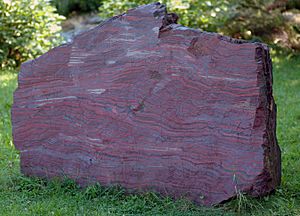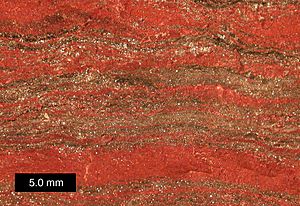Banded iron formation facts for kids
Banded iron formations (or BIFs) are a special kind of rock. You often find them in very old rocks called sedimentary rocks from the Precambrian time. This was a long, long time ago, before most complex life appeared on Earth.
These rocks have many thin layers. Some layers are made of iron oxides, which are like rust. These iron oxides are usually magnetite or hematite. Other layers are made of rocks that don't have much iron, like shale and chert. These layers switch back and forth, making the rock look "banded."
Some of the oldest rocks ever found, formed over 3,700 million years ago, have these banded iron layers. They were very common in Earth's early history.
Contents
Why are Banded Iron Formations Important?
Banded iron formations are very important for two main reasons. First, they tell us a lot about Earth's early atmosphere. Second, they are a huge source of iron for us today.
Earth's Early Oxygen Story
These formations were very common around 2,400 million years ago. This time is known as the Great Oxygenation Event. This was when Earth's atmosphere started to get a lot of oxygen. After about 1,800 million years ago, these formations became less common.
Scientists believe that the total amount of oxygen trapped in these rocks is about twenty times more than all the oxygen in Earth's air today! This shows how much oxygen was produced and then used up in the oceans long ago.
A Source of Iron Ore
Banded iron formations are a major source of iron ore. Iron ore is the rock we dig up to get iron metal. This metal is used to make steel for buildings, cars, and many other things. Important places where these rocks are mined include the Pilbara region in Western Australia, the Animikie Group in Minnesota, and the Carajás Mineral Province in Brazil.
How Did Banded Iron Formations Form?
Most scientists agree on how these amazing rocks were made. It all started in the ancient oceans.
Iron in the Early Oceans
When Earth was very young, its oceans were different. They had a lot of dissolved iron in them. This is because the oceans were acidic, and iron dissolves easily in acidic water. There was very little oxygen in the air or oceans back then.
Oxygen from Tiny Life
Then, tiny living things called cyanobacteria appeared. These bacteria were like early plants. They used photosynthesis to make their own food. Photosynthesis releases oxygen as a waste product.
As these cyanobacteria grew and made oxygen, the oxygen mixed with the dissolved iron in the ocean. When oxygen and iron meet in water, they form solid iron oxides. These iron oxides are not soluble, meaning they don't dissolve in water.
Layers of Iron and Mud
These solid iron oxides then sank to the bottom of the ocean. They formed a thin layer on the seafloor, which was often muddy and had no oxygen. This process is called precipitation.
The banding happened because the amount of oxygen changed over time. Each band is a bit like a varve, which is a yearly layer of sediment. Scientists think that changes in oxygen levels, maybe due to seasons or cycles of bacteria growth, caused the layers to form. One layer would be rich in iron oxides, and the next would be poor in iron, like the mud and chert.
Eventually, as more and more oxygen was produced, the oceans became permanently oxygenated. At this point, most of the dissolved iron had already settled out. After this, banded iron formations became much rarer.
Images for kids
-
A Neoarchean banded iron formation from northeastern Minnesota.
-
The huge Hull–Rust–Mahoning Open Pit Iron Mine in the Iron Range, where banded iron formations are mined.
-
The Tom Price Mine in the Hamersley Range, Australia, another major iron ore mine.
See also
 In Spanish: Formación de hierro bandeado para niños
In Spanish: Formación de hierro bandeado para niños













